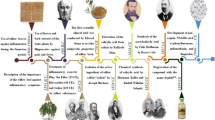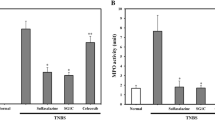Abstract
Sulindac is a non-selective inhibitor of cyclooxygenases (COX) used to treat inflammation and pain. Additionally, non-COX targets may account for the drug’s chemo-preventive efficacy against colorectal cancer and reduced gastrointestinal toxicity. Here, we demonstrate that the pharmacologically active metabolite of sulindac, sulindac sulfide (SSi), targets 5-lipoxygenase (5-LO), the key enzyme in the biosynthesis of proinflammatory leukotrienes (LTs). SSi inhibited 5-LO in ionophore A23187- and LPS/fMLP-stimulated human polymorphonuclear leukocytes (IC50 ≈ 8–10 μM). Importantly, SSi efficiently suppressed 5-LO in human whole blood at clinically relevant plasma levels (IC50 = 18.7 μM). SSi was 5-LO-selective as no inhibition of related lipoxygenases (12-LO, 15-LO) was observed. The sulindac prodrug and the other metabolite, sulindac sulfone (SSo), failed to inhibit 5-LO. Mechanistic analysis demonstrated that SSi directly suppresses 5-LO with an IC50 of 20 μM. Together, these findings may provide a novel molecular basis to explain the COX-independent pharmacological effects of sulindac under therapy.







Similar content being viewed by others
Abbreviations
- AA:
-
Arachidonic acid
- Ada:
-
Adenosine deaminase
- COX:
-
Cyclooxygenase
- cPLA2-alpha:
-
Cytosolic phospholipase A2-alpha
- FLAP:
-
5-Lipoxygenase-activating protein
- fMLP:
-
N-formyl-methionyl-leucyl-phenylalanine
- 5-HETE:
-
5(S)-hydroxy-8,11,14-cis-6-trans-eicosa-tetraenoic acid
- 12-HETE:
-
12(S)-hydroxy-5,8-cis-10-trans-14-cis-eicosatetraenoic acid
- 15-HETE:
-
15(S)-hydroxy-5,8,11-cis-13-trans-eicosatetraenoic acid
- 12-HHT:
-
12(S)-hydroxy-5-cis-8,10-trans-heptadecatrienoic acid
- LC–MS/MS:
-
Liquid chromatography coupled with tandem mass spectrometry
- 5-LO:
-
5-Lipoxygenase
- LPS:
-
Lipopolysaccharide
- LT:
-
Leukotriene
- NSAID:
-
Non-steroidal anti-inflammatory drug
- PGE2 :
-
Prostaglandin E2
- SA:
-
Sodium arsenite
- SC:
-
Sodium chloride
- SSi:
-
Sulindac sulfide
- SSo:
-
Sulindac sulfone
- Sul:
-
Sulindac
References
Parente L, Perretti M (2003) Advances in the pathophysiology of constitutive and inducible cyclooxygenases: two enzymes in the spotlight. Biochem Pharmacol 65:153–159
Grosch S, Maier TJ, Schiffmann S, Geisslinger G (2006) Cyclooxygenase-2 (COX-2)-independent anticarcinogenic effects of selective COX-2 inhibitors. J Natl Cancer Inst 98:736–747
Haanen C (2001) Sulindac and its derivatives: a novel class of anticancer agents. Curr Opin Investig Drugs 2:677–683
Davies NM, Watson MS (1997) Clinical pharmacokinetics of sulindac. A dynamic old drug. Clin Pharmacokinet 32:437–459
Williams CS, Goldman AP, Sheng H, Morrow JD, DuBois RN (1999) Sulindac sulfide, but not sulindac sulfone, inhibits colorectal cancer growth. Neoplasia 1:170–176
Goluboff ET (2001) Exisulind, a selective apoptotic antineoplastic drug. Expert Opin Investig Drugs 10:1875–1882
Funk CD (2001) Prostaglandins and leukotrienes: advances in eicosanoid biology. Science 294:1871–1875
Werz O, Steinhilber D (2006) Therapeutic options for 5-lipoxygenase inhibitors. Pharmacol Ther 112:701–718
Werz O, Burkert E, Samuelsson B, Radmark O, Steinhilber D (2002) Activation of 5-lipoxygenase by cell stress is calcium independent in human polymorphonuclear leukocytes. Blood 99:1044–1052
Fischer L, Szellas D, Radmark O, Steinhilber D, Werz O (2003) Phosphorylation- and stimulus-dependent inhibition of cellular 5-lipoxygenase activity by nonredox-type inhibitors. FASEB J 17:949–951
Brungs M, Radmark O, Samuelsson B, Steinhilber D (1995) Sequential induction of 5-lipoxygenase gene expression and activity in Mono Mac 6 cells by transforming growth factor beta and 1, 25-dihydroxyvitamin D3. Proc Natl Acad Sci USA 92:107–111
Werz O, Steinhilber D (1996) Selenium-dependent peroxidases suppress 5-lipoxygenase activity in B-lymphocytes and immature myeloid cells. The presence of peroxidase-insensitive 5-lipoxygenase activity in differentiated myeloid cells. Eur J Biochem 242:90–97
Werz O, Klemm J, Samuelsson B, Radmark O (2001) Phorbol ester up-regulates capacities for nuclear translocation and phosphorylation of 5-lipoxygenase in Mono Mac 6 cells and human polymorphonuclear leukocytes. Blood 97:2487–2495
Maier TJ, Tausch L, Hoernig M, Coste O, Schmidt R, Angioni C, Metzner J, Groesch S, Pergola C, Steinhilber D, Werz O, Geisslinger G (2008) Celecoxib inhibits 5-lipoxygenase. Biochem Pharmacol 76:862–872
Albert D, Zundorf I, Dingermann T, Muller WE, Steinhilber D, Werz O (2002) Hyperforin is a dual inhibitor of cyclooxygenase-1 and 5-lipoxygenase. Biochem Pharmacol 64:1767–1775
Surette ME, Palmantier R, Gosselin J, Borgeat P (1993) Lipopolysaccharides prime whole human blood and isolated neutrophils for the increased synthesis of 5-lipoxygenase products by enhancing arachidonic acid availability: involvement of the CD14 antigen. J Exp Med 178:1347–1355
Siemoneit U, Pergola C, Jazzar B, Northoff H, Skarke C, Jauch J, Werz O (2009) On the interference of boswellic acids with 5-lipoxygenase: mechanistic studies in vitro and pharmacological relevance. Eur J Pharmacol 606:246–254
Rouzer CA, Ford-Hutchinson AW, Morton HE, Gillard JW (1990) MK886, a potent and specific leukotriene biosynthesis inhibitor blocks and reverses the membrane association of 5-lipoxygenase in ionophore-challenged leukocytes. J Biol Chem 265:1436–1442
Feißt C, Pergola C, Rakonjac M, Rossi A, Koeberle A, Dodt G, Hoffmann M, Hoernig C, Fischer L, Steinhilber D, Franke L, Schneider G, Radmark O, Sautebin L, Werz O (2009) Hyperforin is a novel type of 5-lipoxygenase inhibitor with high efficacy in vivo. Cell Mol Life Sci 66:2759–2771
Fischer L, Hornig M, Pergola C, Meindl N, Franke L, Tanrikulu Y, Dodt G, Schneider G, Steinhilber D, Werz O (2007) The molecular mechanism of the inhibition by licofelone of the biosynthesis of 5-lipoxygenase products. Br J Pharmacol 152:471–480
Brideau C, Chan C, Charleson S, Denis D, Evans JF, Ford-Hutchinson AW, Fortin R, Gillard JW, Guay J, Guevremont D et al (1992) Pharmacology of MK-0591 (3-[1-(4-chlorobenzyl)-3-(t-butylthio)-5-(quinolin-2-yl-methoxy)- indol-2-yl]-2, 2-dimethyl propanoic acid), a potent, orally active leukotriene biosynthesis inhibitor. Can J Physiol Pharmacol 70:799–807
Werz O (2002) 5-lipoxygenase: cellular biology and molecular pharmacology. Curr Drug Targets Inflamm Allergy 1:23–44
Radmark O, Werz O, Steinhilber D, Samuelsson B (2007) 5-Lipoxygenase: regulation of expression and enzyme activity. Trends Biochem Sci 32:332–341
Costa D, Gomes A, Reis S, Lima JL, Fernandes E (2005) Hydrogen peroxide scavenging activity by non-steroidal anti-inflammatory drugs. Life Sci 76:2841–2848
Santos F, Teixeira L, Lucio M, Ferreira H, Gaspar D, Lima JL, Reis S (2008) Interactions of sulindac and its metabolites with phospholipid membranes: an explanation for the peroxidation protective effect of the bioactive metabolite. Free Radic Res 42:639–650
Egan RW, Gale PH (1985) Inhibition of mammalian 5-lipoxygenase by aromatic disulfides. J Biol Chem 260:11554–11559
Riendeau D, Denis D, Choo LY, Nathaniel DJ (1989) Stimulation of 5-lipoxygenase activity under conditions which promote lipid peroxidation. Biochem J 263:565–572
Piazza GA, Alberts DS, Hixson LJ, Paranka NS, Li H, Finn T, Bogert C, Guillen JM, Brendel K, Gross PH, Sperl G, Ritchie J, Burt RW, Ellsworth L, Ahnen DJ, Pamukcu R (1997) Sulindac sulfone inhibits azoxymethane-induced colon carcinogenesis in rats without reducing prostaglandin levels. Cancer Res 57:2909–2915
Soh JW, Weinstein IB (2003) Role of COX-independent targets of NSAIDs and related compounds in cancer prevention and treatment. Prog Exp Tumor Res 37:261–285
Meade EA, Smith WL, DeWitt DL (1993) Differential inhibition of prostaglandin endoperoxide synthase (cyclooxygenase) isozymes by aspirin and other non-steroidal anti-inflammatory drugs. J Biol Chem 268:6610–6614
Oshima M, Murai N, Kargman S, Arguello M, Luk P, Kwong E, Taketo MM, Evans JF (2001) Chemoprevention of intestinal polyposis in the Apcdelta716 mouse by rofecoxib, a specific cyclooxygenase-2 inhibitor. Cancer Res 61:1733–1740
Duggan DE, Hooke KF, Hwang SS (1980) Kinetics of the tissue distributions of sulindac and metabolites. Relevance to sites and rates of bioactivation. Drug Metab Dispos 8:241–246
Huls G, Koornstra JJ, Kleibeuker JH (2003) Non-steroidal anti-inflammatory drugs and molecular carcinogenesis of colorectal carcinomas. Lancet 362:230–232
Melstrom LG, Bentrem DJ, Salabat MR, Kennedy TJ, Ding XZ, Strouch M, Rao SM, Witt RC, Ternent CA, Talamonti MS, Bell RH, Adrian TA (2008) Overexpression of 5-lipoxygenase in colon polyps and cancer and the effect of 5-LOX inhibitors in vitro and in a murine model. Clin Cancer Res 14:6525–6530
Romano M, Claria J (2003) Cyclooxygenase-2 and 5-lipoxygenase converging functions on cell proliferation and tumor angiogenesis: implications for cancer therapy. FASEB J 17:1986–1995
Rainsford KD (1977) The comparative gastric ulcerogenic activities of non-steroid anti-inflammatory drugs. Agents Actions 7:573–577
Rainsford KD (1993) Leukotrienes in the pathogenesis of NSAID-induced gastric and intestinal mucosal damage. Agents Actions 39(Spec No):C24–C26
Cronstein BN, Terkeltaub R (2006) The inflammatory process of gout and its treatment. Arthritis Res Ther 8(Suppl 1):S3
Serhan CN, Lundberg U, Weissmann G, Samuelsson B (1984) Formation of leukotrienes and hydroxy acids by human neutrophils and platelets exposed to monosodium urate. Prostaglandins 27:563–581
Ford-Hutchinson AW, Gresser M, Young RN (1994) 5-Lipoxygenase. Annu Rev Biochem 63:383–417
Werz O, Steinhilber D (2005) Development of 5-lipoxygenase inhibitors—lessons from cellular enzyme regulation. Biochem Pharmacol 70:327–333
Acknowledgments
The work was supported by the “Landes Offensive zur Entwicklung Wissenschaftlich Ökonomischer Exzellenz” (LOEWE), Lipid Signaling Forschungszentrum Frankfurt (LiFF) and the German Excellence Cluster “Cardio-Pulmonary System” (ECCPS). The authors thank Dr. Wesely Mcginnstraub, California, USA, for the linguistic revision of the manuscript. The authors declare no conflicting financial interests. C.P. received a Carl Zeiss stipend.
Author information
Authors and Affiliations
Corresponding author
Additional information
S. D. Steinbrink and C. Pergola contributed equally.
Rights and permissions
About this article
Cite this article
Steinbrink, S.D., Pergola, C., Bühring, U. et al. Sulindac sulfide suppresses 5-lipoxygenase at clinically relevant concentrations. Cell. Mol. Life Sci. 67, 797–806 (2010). https://doi.org/10.1007/s00018-009-0206-0
Received:
Revised:
Accepted:
Published:
Issue Date:
DOI: https://doi.org/10.1007/s00018-009-0206-0




